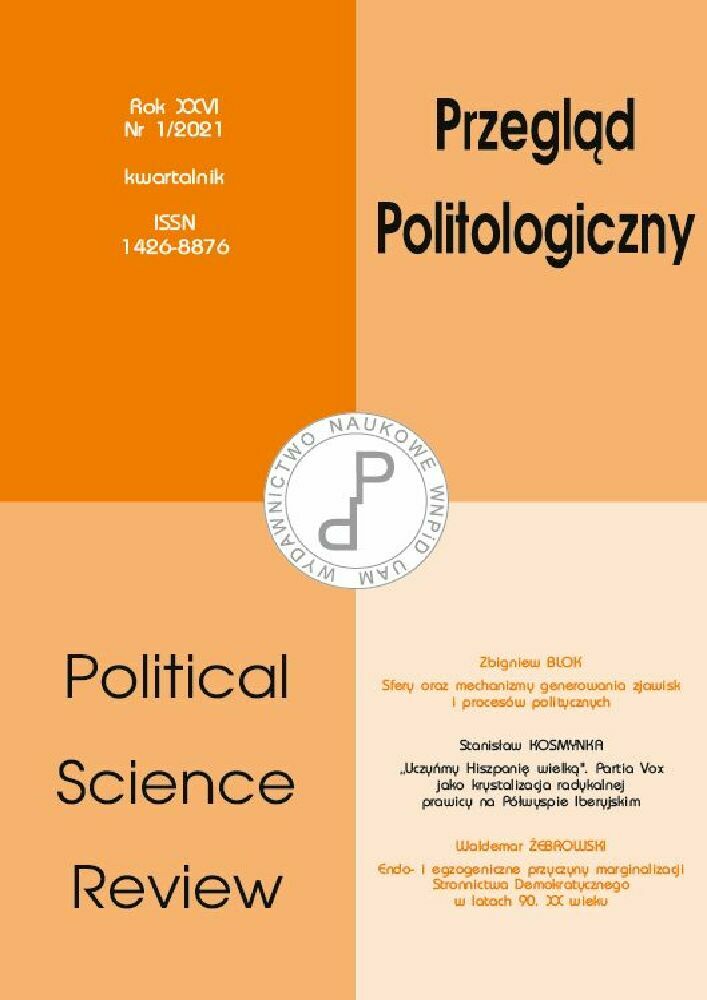Abstrakt
Celem artykułu jest analiza wszechobecnego współcześnie pojęcia fake news oraz jego potencjalnego wpływu na funkcjonowanie państw demokratycznych. Pierwsza część tekstu traktuje o problemie definicyjnym związanym z terminem fake news. W artykule wskazane zostało, że nie istnieje obecnie zgoda na wspólną definicję zjawiska fake news oraz że pojęcie to dotyczyć może zarówno treści pisanych, jak i zamieszczanych zdjęć czy filmów. Ponadto w tekście podjęta została próba analizy zagrożeń, jakie niesie za sobą tworzenie oraz dystrybuowanie treści dezinformacyjnych. Mogą one wpływać zarówno na pojedynczych obywateli, jak i na całe społeczeństwa (np. w ramach procesów wyborczych). W drugiej części artykułu autorka skupia się na wskazaniu rozwiązań, jakie obecnie proponuje się w celu przeciwdziałania fake news, a więc na wdrażaniu kampanii edukacyjnych na temat dezinformacji oraz na proponowaniu dobrych praktyk w tym zakresie. Tekst ukazuje również najbardziej radykalną formę zwalczania fake news, jaką jest wdrażanie sankcji karnych za propagowanie treści dezinformujących. W artykule podkreślone zostało, że ostatni z wymienionych sposobów walki z fake news może nieść za sobą zagrożenie dla demokracji, a zwłaszcza dla prawa do wolności słowa. W celu napisania artykułu posłużono się metodami badań teoretycznych, a zwłaszcza: analizą i syntezą oraz metodami wnioskowania.
Bibliografia
Amnesty International, https://www.amnesty.org/en/.
A multi-dimensional approach to disinformation (2018), Report of the independent High level Group on fake news and online disinformation, European Commission.
Allcott H., Gentzkow M. (2017), Social Media and Fake News in The 2016 Election, „Journal of Economic Perspectives” 31 (2), ss. 211–236.
Bąkiewicz K. (2019), Wprowadzenie do definicji i klasyfikacji zjawiska fake newsa, „Studia Medioznawcze”, t. 20, nr 3 (78), ss. 280–289.
Fighting Fake News. Workshop raport (2017), The Floyd Abrams Institute for Freedom of Expression, Reporthttps://law.yale.edu/sites/default/files/area/center/isp/documents/fighting_fake_news_-_workshop_report.pdf.
Grzegorzewski K. (2011), „Judenfrage”. Retoryczny obraz propagandy antysemickiej w III Rzeszy (na przykładzie publicznych wypowiedzi Adolfa Hitlera i innych polityków NSDAP w latach 1933–1945), „Folia Litteraria Polonica”, nr 14, ss. 141–153.
Honest Ads Act, S.1989 – 115th Congress (2017–2018), https://www.congress.gov/bill/115th-congress/senate-bill/1989/text.
Initiatives to Counter Fake News: China (2019), The Law Library of Congress, https://www.loc.gov/law/help/fake-news/china.php#_ftn6.
Internet World Stats (2019), Internet Usage Statistics, The Internet Big Picture, World Internet Users and 2020 Population Stats, https://www.internetworldstats.com/stats.html.
Konstytucja Stanów Zjednoczonych Ameryki, http://libr.sejm.gov.pl/tek01/txt/konst/usa.html.
Lee T. (2019), The global rise of “fake news” and the threat to democratic elections in the USA, „Public Administration aand Policy: An Asia-Pacific Journal”, vol. 22, no. 1, ss. 15–24.
Mason L. E., Krutka D., Stoddard J. (2018), Media Literacy, Democracy, and the Challenge of Fake News, „Journal of Media Literacy Education”, 10(2), ss. 1–10.
Park. A, Youm Kyu H. (2018), Fake News from a legal perspective: The United States and South Korea compared, „Southwestern Journal of International Law“, 24, no. 1.
Pofma (2019), Protection form online falsehoods and manipulation act, no. 18 of 2019.
Quandt T., Frischlich L., Boberg S., Schatto-Eckrodt T. (2019), Fake News, in: The International Encyclopedia of Journalism Studies, eds. T. P. Vos, F. Hanusch, D. Dimitrakopoulou, M. Geertsema-Sligh. A. Sehl, https://doi.org/10.1002/9781118841570.iejs0128.
Reuters (2019), https://www.reuters.com/article/us-singapore-fakenews/singapore-invokes-fake-news-law-over-opposition-party-posts-idUSKBN1YI0DF.
Singapore Democratic Party v Attorney-General [2020] SGHC 25, Originating Summons No. 15 of 2020.
Statista (2019a), Most popular mobile internet activities according to internet users worldwide as of 2nd half 2017, by device, https://www.statista.com/statistics/249761/most-popular-activities-carried-out-on-mobile-internet-devices/.
Statista (2019b), Most likely sources of fake news stories in the United States as of January 2017, https://www.statista.com/statistics/697774/fake-news-sources/.
Statista (2020), Number of social media users worldwide (in bilions), https://www.statista.com/statistics/278414/number-of-worldwide-social-network-users.
Synopsis report of the public consultation on fake news and online disinformation (2018), European Commission.
Tandoc Jr. E. C., Wei Lim Z., Ling R. (2017), Defining Fake News. A Typology of Scholarly Definitions, „Digital Journalism”, 6(3), ss. 1–17.
The International Fact Checking Network, https://www.poynter.org/ifcn/.
Ustawa z dnia 7.11.2016 r. o cyberbezpieczeństwie Chińskiej Republiki Ludowej, https://perma.cc/3HAP-D6MZ.

